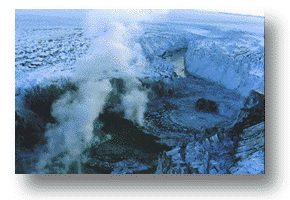
THURSDAY OCTOBER 17 1996
Waiting for the flood
he eruption under the Vatnajökull glacier which began with an earthquake
measuring 5.4 on the Richter scale at 10:48 on 1 October is believed by many
experts to have ceased its spectacular activities - for the time being at least.

Photo by Magnus Tumigudmundsson
With the last wisps of steam clearing in the overhead skies scientists were able
to at last see the full extent of Iceland's fourth largest eruption of this century.
Lying like an open wound, a 3.5km long and 350m wide ice canyon scarred the
ash-blanketed ice-cap. But it was what was within this giant fissure however,
that excited the men of science. A mountain had arisen, resembling a small
island surrounded by a mist-laden sea.
In a soon to be published article in Iceland Review Nature and Travel magazine,
Magnús Tumi Gudmundsson, a geophysicist at the University of Iceland and a
specialist in volcanic activity in the area, explains the significance of this
spectacular natural phenomenon and what scientists can learn from studying it:
"What makes this eruption so unique and of particular scientific interest is that
for the first time it is possible to follow from the beginning how a sub-glacial
eruption develops. It is sub-glacial venting that has probably shaped the
Icelandic landscape more than anything else."
Gudmundsson says that the volcanic area will soon be consumed by the glacier,
even as soon as this winter. This depends on the level of geothermal heat and a
possible resumption of volcanic activity.
For now though, it is the melt water resulting from the battle between fire and
ice that most concerns the experts. They believe that a gigantic flood could burst
forth at any time from the huge sub-glacial caldera Lake Grímsvötn into which
the water streamed, threatening the destruction of roads and bridges along the
only land route linking southern and eastern Iceland. Local farmers however
dispute modern science saying it will not occur until the thaw of next spring.
The nation waits.


